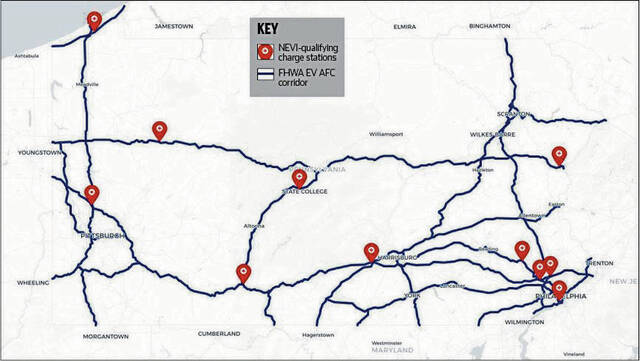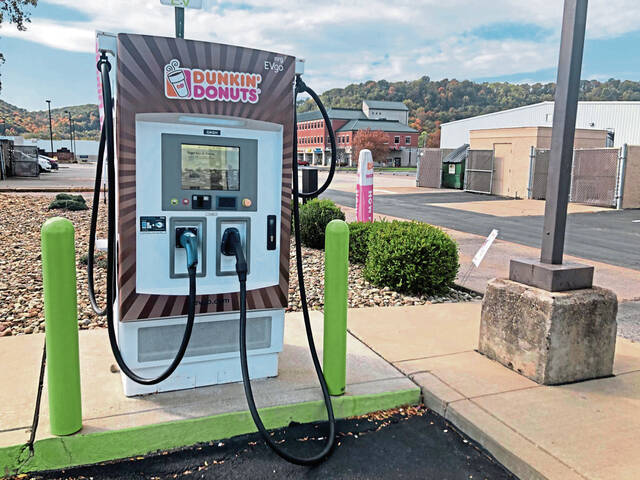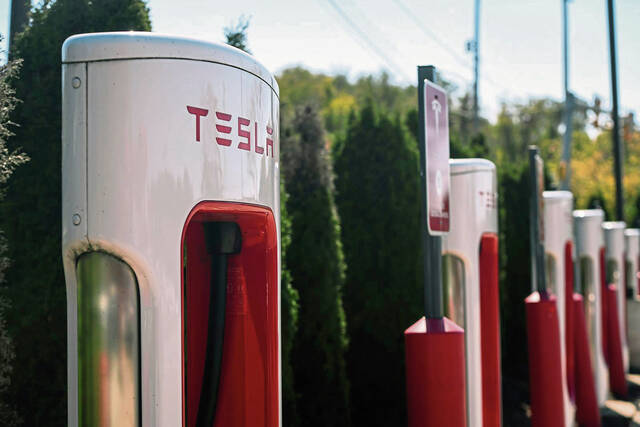Pa. plan for electric vehicle supercharger stations becoming reality
Davie Huddleston wasn’t looking for an electric vehicle. He loves his gas-powered Nissan Murano convertible. But his two daughters kept insisting, and he finally bought one.
“They should sell electric vehicles,” he said of his daughters. “It was constant. And they had a point for my every objection. But it was good. I got it in December, right before gas prices went up so much.”
Huddleston, 76, of Stanton Heights, was charging his satin black Tesla on Tuesday at Sheetz in North Huntingdon. Though he usually charges at home overnight, there are times like Tuesday, or on a recent trip to a funeral, when he has to stop and fast-charge, and that’s not always convenient.
“I drove it to D.C. on the turnpike; there was one at Somerset, but I wasn’t ready to charge. I had to get off at Breezewood, and it was so busy there. There should be more,” Huddleston said. “I’m looking forward to what the president wants to do with building more.”
President Joe Biden’s plan to construct more fast-charging stations is moving forward, and Pennsylvania recently received the first installment of the $170 million it will receive over the next five years. With the money, the state will build an electric vehicle charging network along the busiest routes, partnering with businesses along the way.
The $25.4 million award announced Sept. 14 is part of the National Electric Vehicle Infrastructure Formula Program created under the bipartisan Infrastructure Law. The Biden administration has set a goal of having half of all new cars sold in the country by 2030 be electric battery powered.
General Motors is in the second year of a $35 billion, five-year plan to increase production of EVs on its way to what it calls a full “zero emission vehicle future” by 2040. Ford said it plans to build 2 million EVs annually by 2026. Volkswagen has said it will not produce a new internal combustion platform after 2026 and expects to offer 70 purely battery-powered models by the end of the decade.
The federal program to charge those vehicles calls for $5 billion over five years and has a goal of 500,000 fast chargers nationwide.
The program requires states to submit plans for how they will use the funding to increase the public availability of the stations, which provide most electric vehicles — or EVs — with an 80% charge in about 20 minutes, according to EV Safe Charge, a company that provides commercial and residential charging station installation and management.
As a condition of the program, PennDOT first must use the funds to build what is being termed nationally as the alternative fuel corridor. All of the interstates and most limited-access highways in Pennsylvania are part of the corridor. In the latest round of approvals, PennDOT added U.S. routes 1 and 422.
“Look at this as a national buildout. The big thing is addressing the confidence range,” said Mark Kopko, PennDOT’s director of transformational technology. “We don’t want that to be the deciding factor on whether someone chooses to buy an EV or not.”
Requirements
To be considered “built out,” there must be a fast-charger at least every 50 miles along the route and the chargers must be within 1 mile of a highway exit. To qualify for the federal designation, chargers must have four ports and be capable of delivering 150 kW simultaneously to each vehicle, Kopko said.
The requirements for the corridor program were updated recently, and some fast chargers that were in compliance will need a waiver to count toward the program total. The number of plugs available, distance from the exit and a lack of enough overall power can disqualify a station.
A few spots over from Huddleston at the Sheetz, Blaise Vera, 23, said he endorses the idea of having more fast-charging stations available. Vera said he works for Bartlett Tree Experts in Irwin, lives in Squirrel Hill and frequently drives his Tesla to California Borough in Washington County to see his girlfriend.
He often charges overnight at home, but he said he stops to fast charge once or twice per week, usually spending about $8 or $9 to get his battery from about 40% to near full, which according to his Tesla’s onboard computer, should power 264 miles. Vera said actual mileage varies depending on hilly terrain.
“I haven’t had a lot of trouble finding superchargers because the Tesla finds them and I have an adapter. It takes a lot of planning, but I would rather sit here than pay $100 over there,” Vera said, pointing to the gas pumps.
There are 1,203 public fast-charging stations totaling about 2,800 connections in the state, according to PennDOT. The stations can be found at malls, restaurants, hotels, parking garages and other standalone locations.
The lack of chargers in some areas and the reliability of existing ones are things Rob Delorie, 56, of Turtle Creek said he would like to see improved as he plugged in his Tesla at the North Huntingdon Sheetz.
“It is common for chargers to be broken. They are not well maintained. There is a plaza in Murrysville where there are four EV chargers, and none of them worked,” Delorie said. “That is difficult when you are planning a trip around it.”
Charles and Linda Gutfeld said encountering broken charging stations have been a problem since swapping their 11-year-old Honda Fit for a Chevrolet Volt in July.
“I think some of the charging companies have overextended themselves by installing more stations than they have the ability to maintain,” Charles Gutfeld, 75, said while he and his wife stopped at the Sheetz charging station in Harmar on Thursday.
Linda Gutfeld, 73, said the need to stop and charge the car when traveling long distances “adds significantly to the length of a trip,” but good planning can help avoid wasting time.
Candice Eckhardt of New Philadelphia, Ohio, was making the 400-plus-mile trek to Widener University in Philadelphia on Monday when she stopped for a recharge at the Sheetz in Harmar.
A graduate student, Eckhardt said she uses an app to find a charging station that matches her 2022 Ford Mustang Mach E’s system.
“It’s usually pretty easy (to find stations),” Eckhardt said. “Now that I’ve made this route a few times, this is one I typically stop at. Apple Maps will tell me where I need to stop based on the charge of my vehicle. I have three stops that I make just in case one of the chargers isn’t working.”
She said it takes about a half-hour, maybe less, to get a full charge, and she can travel about 280 miles before nearing energy depletion. It costs about $15 for a full charge.
“(With) my typical driving habits, it will cost me about $20 a month to charge this car,” Eckhardt said. “That is way cheaper than gas. Unless I’m going to school, pretty much everything’s within a 15-mile radius.”
Ibrahima Diane, 36, of Philadelphia, learned a hard lesson about better planning during a recent trip in his electric Kia sedan.
“My battery died on the way from Philly to Ohio, and I had to get the car towed,” he said while charging at the Sheetz in Harmar during the return trip on Thursday. “I was using an app to find the charging stations, but I didn’t get to one in time.
“I’ll be going back and forth about twice a month and will plan my trip better in the future.”
Easing access
Placing chargers in communities distant from major highways could be completed after the corridor is completed. PennDOT’s goal is for 95% of state residents to live within 15 miles of a public charging station and for at least half of municipalities to have at least two Level 2 stations that are always open.
The department soon will begin accepting grant applications for placement of fast chargers along the corridor. The federal money, funneled through PennDOT, will fund 80% of the cost of a charging station. Partnering groups and companies are expected to put up the rest.
Anyone who can meet the state and federal requirements is eligible to apply for the grants, but PennDOT is expecting most applicants to be companies that build the chargers and site owners who want to draw traffic to their establishments, such as restaurants, convenience stores and other retail operations.
“People want them where they can get out of the car and buy amenities … use the restroom or get something to eat,” Kopko said.
That is what Vera said he did when he drove his car from Pittsburgh to Carmel, Ind., and then to Chicago. He stopped a few times.
“It worked out. The first stop, it was time to get something to eat,” Vera said. “And for the second one to get to the middle of Indiana, we wanted to get out of the car and get a drink and stretch our legs.”
Sheetz said it has four stores in Allegheny and Westmoreland counties offering chargers, with plans for more.
In addition to the federal money to build the charging network, Pennsylvania is using money from the Volkswagen consent decree related to the company’s violation of the Clean Air Act. The agreement included a fund for government to pay for zero-emission transportation programs.
Sheetz, Coen Markets and Giant Eagle recently were awarded grants from that program.
Sheetz will use $250,000 from the funds to install four plugs at its New Stanton location off Interstate 70. Coen will install two at the store off the Donegal exit of the turnpike in Westmoreland County and two at the Coen Markets Travel Plaza in Claysville, Washington County. The company was granted $240,000 for each. Giant Eagle will use $210,000 to install two plugs at a GetGo within 1 mile of I-79 near Waynesburg in Greene County.
David E. Martin of Bethel Park, who has owned Teslas since 2019, said having these charging stations will help boost the popularity of electric vehicles.
He admits “range anxiety” — the fear of running out of fuel — was on his mind before buying an EV, but his confidence has grown as he has driven across the state on longer trips.
“There is a supercharger I use at the Somerset station of the turnpike. You put the car on the charger and get a sandwich,” Martin said. “You come back out, and it is charged.”
He said new construction projects should be required to have universal EV chargers and communities should expect developments — such as traditional gas stations — to install them as well.
“Getting them near highways,” Martin said, “that just makes it easier and easier to get people to drive electric.”
Dan Sleva is a Tribune-Review staff writer. You can contact Dan at dsleva@triblive.com.
Remove the ads from your TribLIVE reading experience but still support the journalists who create the content with TribLIVE Ad-Free.











